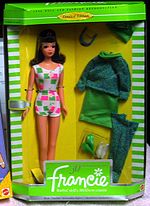
Francie (Barbie doll)
Encyclopedia

Fashion doll
Fashion dolls are dolls primarily designed to be dressed to reflect fashion trends. They are manufactured both as toys for children to play with and as collectibles for adult collectors. The dolls are usually modeled after teen girls or adult women, though child, male, and even some non-human...
issued by Mattel
Mattel
Mattel, Inc. is the world's largest toy company based on revenue. The products it produces include Fisher Price, Barbie dolls, Hot Wheels and Matchbox toys, Masters of the Universe, American Girl dolls, board games, and, in the early 1980s, video game consoles. The company's name is derived from...
from 1966 to 1976. Marketed as "Barbie
Barbie
Barbie is a fashion doll manufactured by the American toy-company Mattel, Inc. and launched in March 1959. American businesswoman Ruth Handler is credited with the creation of the doll using a German doll called Bild Lilli as her inspiration....
's MODern cousin" (sic), the doll had an extensive line of "mod"-style clothing, often employing bright colors and geometric patterns similar to fashions associated with Carnaby Street
Carnaby Street
Carnaby Street is a pedestrianised shopping street in London, United Kingdom, located in the Soho district, near Oxford Street and Regent Street. It is home to numerous fashion and lifestyle retailers, including a large number of independent fashion boutiques...
in the late 1960s to early 1970s. At 11¼ inches tall, the Francie doll was shorter than Barbie, but taller than Skipper, making the character presumably between the two in age.
Origin
In 1965, Mattel began to consider changing Barbie to reflect modern trends of the times. Fearful of losing their core customer base, they decided to produce a "test" doll first, and introduced Francie in 1966. She featured a body reflecting that of a young teen, with a smaller bust, flip hairdo, rooted lashes (on the bend leg dolls only) and a slight figure. Some believe that the Francie doll may have been based on the character "Gidget", whose real name was Frances Lawrence (sometimes called Francie). Francie was such a smash hit that she led the way for Barbie's makeover and MOD debut in 1967.Models and variations
Francie came in several configurations over the course of her decade-long run, beginning with a straight leg model (1966–1968) and a "bend leg" doll (1966–1967). "Twist 'N Turn" dolls were issued beginning in 1967, then with a short flip hairstyle from 1969–1970 and finally in a no-bangs hairstyle in 1971. All of these dolls were available in blonde or brunette and had rooted lashes, except for the straight leg dolls, who had painted lashes.In the 1970s, several hair-related variations of the Francie doll were issued: "Hair Happenin's Francie" in 1970-1972, a "Growin' Pretty Hair" model from 1971-1973 both in blonde only; and a "Quick Curl Francie" with brunette hair in 1973-1974. A tanned version of Francie, "Malibu Francie" was made from 1971 to 1976 with blonde hair, blue eyes and utilized the Casey head mold. "Busy Francie" (1972–1973) was a blonde doll designed with a hand that was able to grip small objects. 1975's "Baggie Francie" was the last of the Francie dolls, and was made with brunette hair.
A "colored Francie", first issued in 1967, was the first doll in the Mattel line with a truly dark complexion. However, the doll did not have genuinely African American features, since it was made with the same head molds as the Caucasian Francie doll. Because of this, a doll named Christie, first issued in 1968, is often considered the first true African American doll in the Barbie line. "Black Francie" was not labeled as "Barbie's Modern cousin."
A German variation of Francie was produced and sold in 1972. Made with a different head mold, but the same body type as her US counterparts, she was sold only in Germany and produced as a standard doll and a "Busy" variation. These dolls had blonde hair and blue eyes.
Francie has been reproduced by Mattel three times: 1996, as a bend leg doll in brunette with a reproduction swimsuit and Gad-Abouts outfit; 1997, as Black Francie (limited to 5,000 dolls) wearing a reproduction of The Wild Bunch; and in 2005, as a blonde no-bangs Francie, wearing a reproduction of Smashin' Satin.
Francie's friends
A second doll in Francie's size, Casey, was issued as "Francie's fun friend" from 1967 and came in blonde or brunette. That same year a Twiggy doll (based on the famous fashion model) was also made, resembling Casey but with heavier painted-on "makeup". The Twiggy doll was made through 1968, and Casey through 1970. Casey returned briefly in 1975 as "Baggie Casey", but she was made with the same head mold as Francie.In the 1971 Mattel catalog, there were pictures of a new doll named "Becky". She was made from the Casey head mold, was hand painted and shown in blonde, although prototypes of her were made in blonde, brunette and redhead. Eventually, for reasons unknown, Mattel decided not to mass produce Becky. Some 1971 fashions could be found in stores labeled as being for "Francie and her new friend Becky" and are highly sought after by collectors. In 2009, Mattel released the Becky doll called "Most Mod Party Becky", and featured Becky with ash blond hair, 3 outfits, shoes, brush, and accessories such as a phone, tray, drinks, party invitations, and record player with record.
The Japanese market had an exclusive friend of Francie, named Tuli-Chan. She was sold in 1974, and had the Quick Curl Francie body. A set of her own outfits was also sold.

